With the ongoing digital transformation of the public sector, agile methods are becoming increasingly relevant for government institutions. To better understand and illustrate this phenomenon Maximilian Kupi crawled and analysed the web content of about 50 British and German government domains. From a German perspective, the results are rather sobering.
The digital transformation is continuously changing more and more aspects of our lives. From the way we communicate to the way we find the right path or even the love of our life – nothing remains untouched by digital technology. In line with this, digital interaction channels have seen an increase in relevance for the private and public sector alike. Yet, in order to digitally transform any organisation, a simple transfer of analog practices into the digital realm will not do: Much rather digital transformation requires organisational and relational changes in order to better satisfy the users’ needs and fully reap the benefits that digital technologies can bring. In that respect, the adoption of agile methods has increasingly become the mantra for many public sector institutions.
Agile approaches originate from the IT departments of private sector companies, and are characterised by the incremental and iterative development, testing, and improvement of technology products with a focus on the user (Mergel, 2016).
Values of agile software development
Value 1 Individuals and interactions over processes and tools
Value 2 Working software over comprehensive documentation
Value 3 Customer collaboration over contract negotiation
Value 4 Responding to change over following a plan
Source: Agile Manifesto, 2001.
However, as more and more non-IT related teams have come to value digital technologies as an integral part of their work, agile methods such as Scrum or Kanban began to expand beyond these departments. In that respect various digital government units such as the United Kingdom’s, United States’ or Canada’s government digital service are regarded as the lead organisations that ”paved the way” for other government departments to also introduce agile methods (Mergel et al. 2020). However, apart from these prominent examples, little is known about the extent to which these methods are actually prevalent in other government institutions. For that matter I have analysed the appearance of agile related keywords on British and German government websites over time. With its much cited digital transformation efforts, the United Kingdom thereby serves as the baseline against which German government institutions are assessed.
I crawled a total of 49 government domains (federal and state level) and downloaded over 170k potentially agile related pages with the help of a self-implemented online data collection system. After preprocessing – e.g. extracting the publishing organisation’s name and the publishing date – and cleaning the data, 451 relevant sites were left. I analysed the obtained web content with respect to (a) the number of published web pages mentioning agile methods over time as well as (b) the occurrence of further agile related co-search terms (e.g. scrum, sprint, design thinking) as proxy measure for how in-depth the methodology is described on the respective web pages. These are the three main findings of my analysis:
1. Agile methods’ importance has risen substantially over the past years.
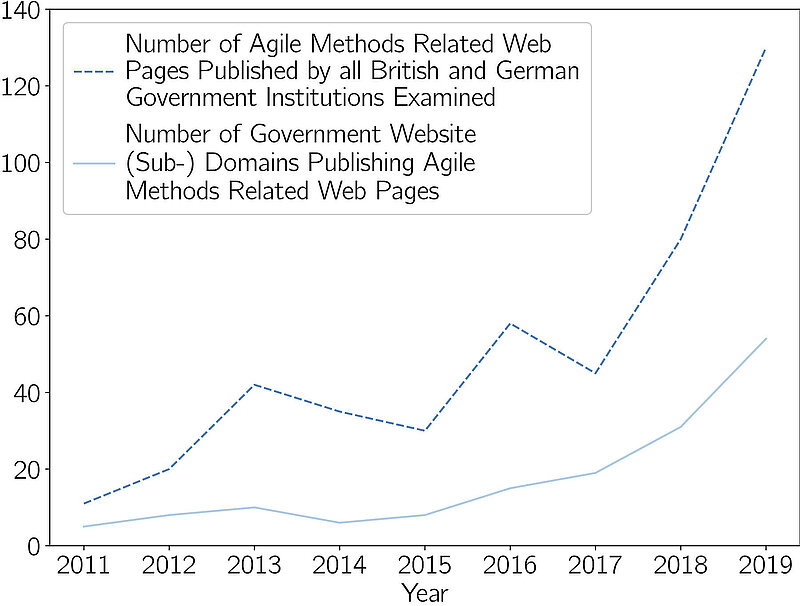
As the graph shows the publication of agile related web content comes in waves and there has been a particularly steep increase in the number of websites published between 2017 and 2019 (about 290%).
2. Compared to Germany, British central government institutions have a substantial lead – with regard to quantity, timing, and depth – in publishing agile methods related pages on their web presences.
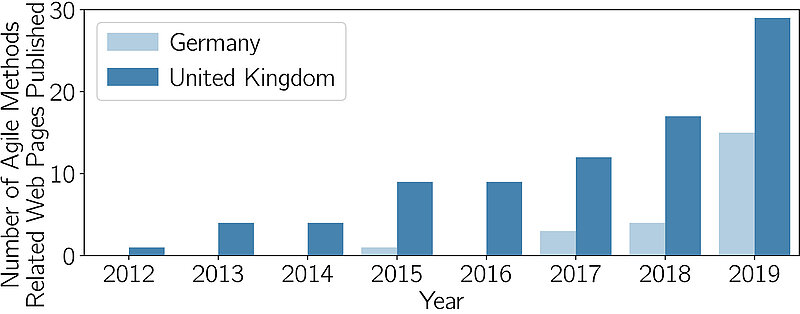
It shows that British central government institutions started publishing agile related content already back in 2012 – three years earlier than the respective German institutions. Overall they also published about four times more agile related content in total.
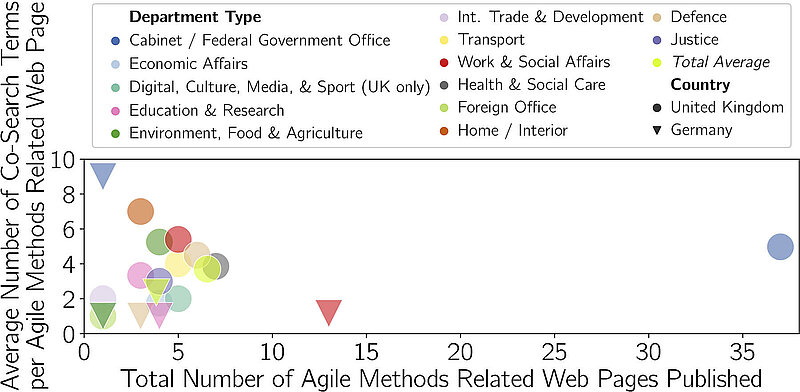
Also, graph number 3 shows that the number of British institutions publishing agile related content (round dots) is more than twice as high and they published about 1.7 times more pages on average. Furthermore, they have an about 1.6 times higher total average number of co-search terms per site. The most active British institution (Cabinet Office, 37 sites) has 2.85 times more published agil* sites than the most active German institution (Ministry of Labour & Social Affairs, 13 sites).
3. British central government shows greater knowledge about the specifics of agile methods and seems to put more focus on the user, while the descriptions on the web pages of German institutions are rather shallow.
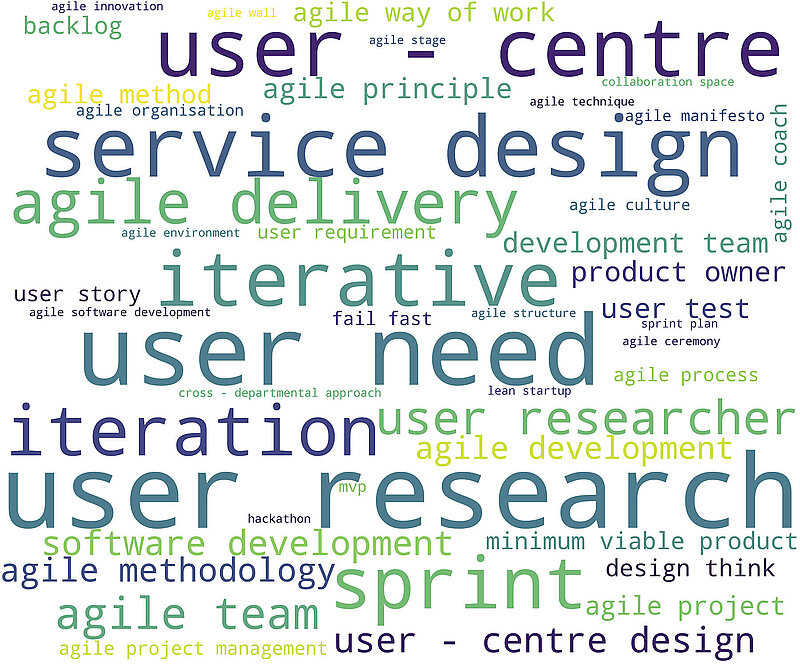
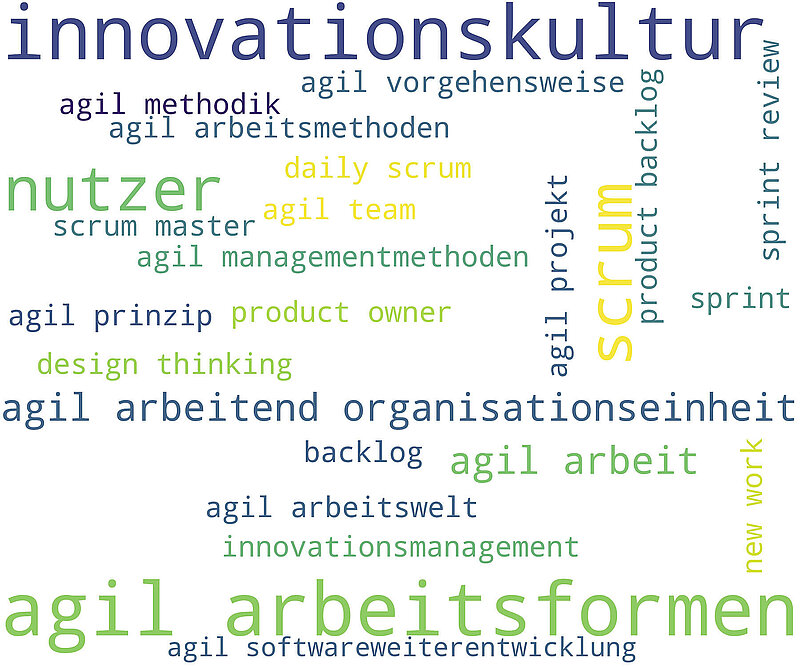
All in all, my analysis of government institution website content revealed that agile methods have become a clearly identifiable trend in the public sector and Germans are late to the party. To catch up, they could more strongly acknowledge the strategic relevance of agile methods for government’s digital transformation, and consider establishing distinct lighthouse institutions that internally push the application of agile methods and openly talk about it (e.g. on dedicated online blogs) so that other institutions can follow.
About the authors
-
Maximilian Kupi is a PhD researcher at the Centre for Digital Governance. He is interested in understanding the adoption of agile methods in the public sector. He holds a Bachelor in Philosophy and Economics as well as a Master of Public Policy and has worked as an innovation consultant and coach.


